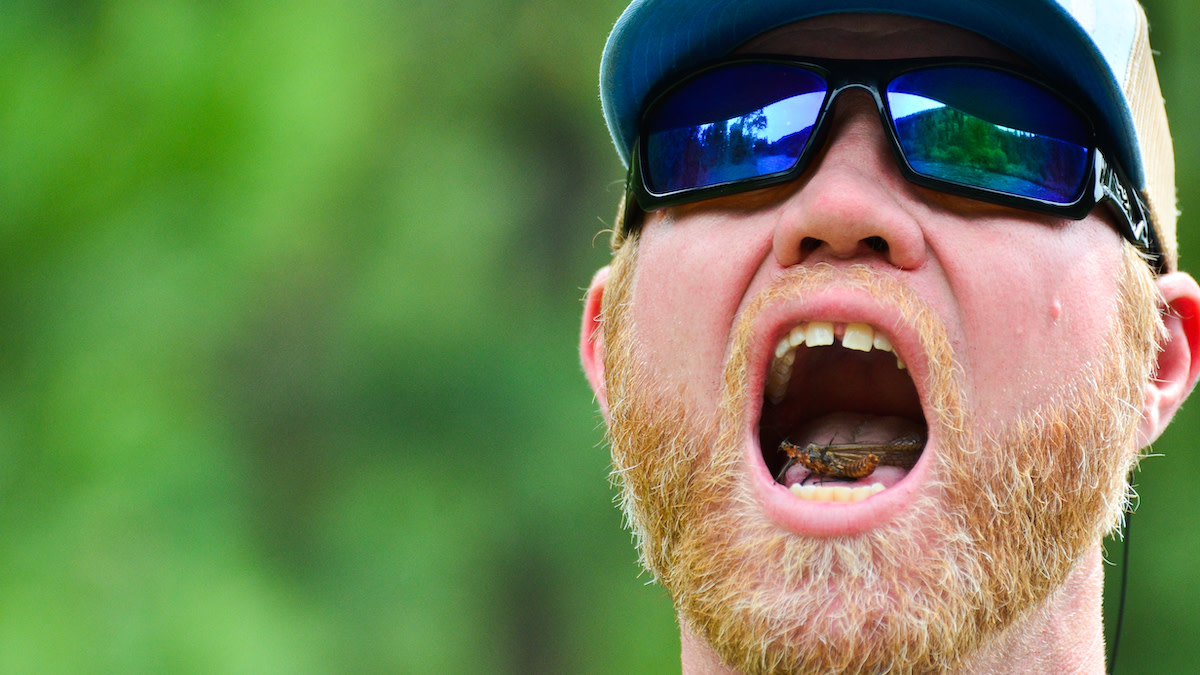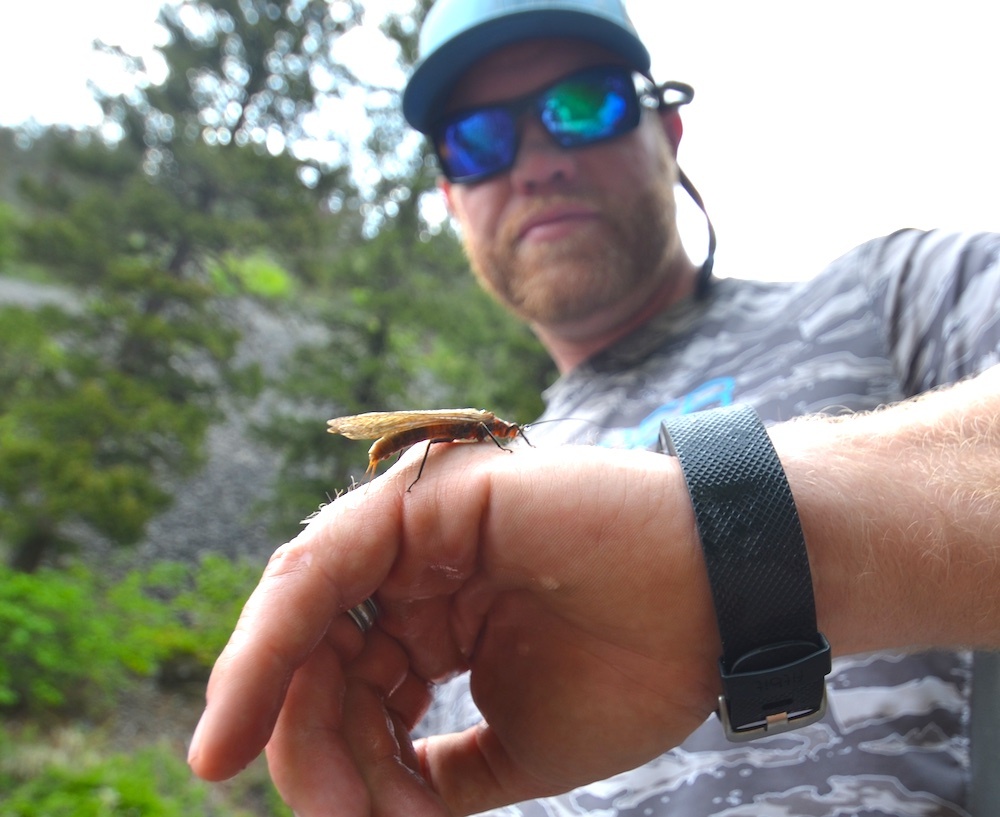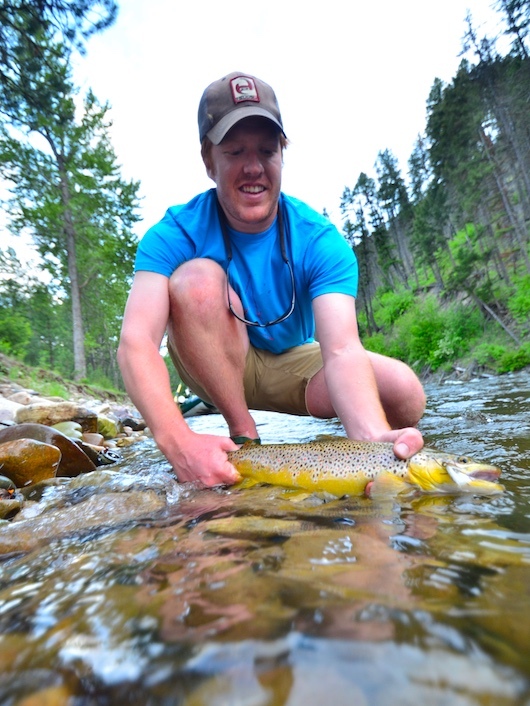
Nearly all of us go through “the bug stage” as kids. We watch spiders spin webs, catch fireflies in jars, dig for worms in the garden, and obsess over every tiny being that creeps, crawls, flutters, or flies around us. Thankfully, most grow out of it. But not all. Some people never lose their love of insects and grow into bug-loving adults. Some of these people become entomologists or serial killers, but many simply become fly anglers.
Those folks who fish with feathers are some of the biggest bug nerds on the planet. They learn the minute differences between every species and subspecies. They learn about life cycles and can identify creatures by their Latin names. These anglers are constantly searching the skies for flying mayflies, turning over river rocks in search of stonefly nymphs, or getting distracted by caddisflies hovering around porch lights.
Fly anglers love insects because trout love insects. Each bug an angler finds tells a little more about what the trout are feeding on. Of the plethora of aquatic and terrestrial bugs that interest fly fisherman, there is no other whose emergence is met with more drooling anticipation and strange tradition than the hatch of the mighty stonefly—king of the trout bugs.

What Are Stoneflies? There are around 2,000 different species of stonefly ranging in size as adults from nemouras of only a few centimeters to giant salmonflies over 2 ½ inches long. Stoneflies are prent on nearly every continent. Though the size and color of each species vary, their basic profile is very similar. Adults all have two long antennae, small chewing mouthparts, and two sets of wings. The nymphs look much like the adults, just bulkier and with gills instead of wings.
While caddisfly and mayfly hatches draw a lot of interest from feeding trout, stonefly hatches command the attention of the biggest trout in the stream. Both stonefly nymphs and adults are generally the largest insects in the river, creating the largest biomass and feeding opportunity for trout all year. Rather than chasing down baitfish or rooting the river bottom for crayfish, for big trout, stoneflies provide a significant meal with little effort.
In the West, where stonefly hatches get the most attention from anglers, there are five primary species of stonefly you should know about and be able to recognize: Salmonfly (Pteronarcys californica), black and bright orange, 1 to nearly 3 inches; golden stone (Acroneuria californica), yellow to bronze, 1 inch plus; skwalla (Alloperla delicate), gray or drab olive, up to 1 inch; yellow sally (Alloperla pallidula), bright yellow or lime green, up to 1/4 inch; and nemoura (family Nemouridae) black or brown, 1/8 inch or smaller.
These five groups emerge almost throughout the entire year, with the nemouras arriving in late-winter and early spring, the skwallas following closely behind them, salmonflies and goldens in late spring into the summer, and yellow sallies appearing sometimes into early fall.
Determining which stonefly species is hatching is often vital to success. A size 14 yellow sally will not evoke a giant salmonfly closer to size 2. Stonefly hatches are usually quite predictable by calendar date, so it can pay to visit a local fly shop to learn more. But you can also do a lot of the sleuthing yourself by simply turning over rocks at the rivers edge. You can pretty easily figure out which bugs are hatching or soon to hatch by looking closely at the edge of the water for a few minutes.
How to Fish a Stonefly Hatch In order to properly fish a stonefly hatch in all of its stages, it’s important to understand their full life cycle. Adult female stoneflies lay around 6,000 eggs. After hatching, the small nymphs begin their lives on the riverbed, living in crevices between rocks. As they mature, the nymphs slowly begin to migrate towards the top of the riverbed. They feed on algae and the nymphs of other aquatic insects while swimming in the current and crawling across rocks before continuing their migration to the edges of the stream. Once there, the nymphs leave the water, crawl onto rocks, into bushes, and even into trees. Here they emerge, breaking out of their exoskeletons and growing into winged adults. They leave behind their nymphal shucks and fly out over the water to breed then die.
Anglers can fish the stonefly hatch throughout its entire cycle, capitalizing on the insect’s presence in the river by fishing nymph patterns in the early stages of the stonefly emergence, and dry flies during the latter half of their life cycle when the when the adults are breeding, flying around, and falling onto the surface of the water. It’s important to know what insect is happening any given moment and what stage the bugs are in. That will help you pick your fly pattern and tactics.
Fishing with Stonefly Nymphs Stonefly nymphs can be used to catch trout throughout the entire year. Many stonefly species spend two to four years as nymphs in the bottom of the river, acting as the main forage for many trout species, even during the winter. When fishing stonefly patterns before they begin to migrate to the edges of the river, it’s best to use smaller, more discrete fly patterns such as the Little Black Stone or the OE Stonefly Nymph that don’t necessarily imitate any particular stonefly species but instead emulate many of them.
The very best time to fish with stonefly nymphs is when they are on the verge of emergence. When they’re swimming and crawling through faster currents and riffles close to shore is when trout truly begin concentrating on these morsels. Fish will be found along the edges of the river at this time, hunting and feeding. It’s important to note that during mass stonefly hatches such as the salmonfly or skwalla hatches, that the great numbers of nymphs can cause the trout to become extremely selective, so it’s best to use more detailed and realistic patterns. Nymph patterns such as the Girdle Bug and the Knuckle Dragging Stonefly nymph in the appropriate size and color for whatever stonefly species is hatching work extremely well during this time.
There are a couple of simple ways to rig and fish stonefly nymphs properly. The first and probably most popular is fishing them underneath a strike indicator. To do this, tie two stonefly nymphs to a length of fly leader approximately one to two feet longer than the depth of the water you are fishing. Add a small split shot or two to the leader when fishing faster or deeper water. This ensures that the flies reach the proper depth quickly. Secure an indicator to the top of the leader and then cast the rig upstream, mending accordingly to ensure that the flies are drifting at the same speed as the current. This same rig can also be fished without an indicator, with the angler holding a tight line that drifts at the same speed as the current, feeling for a strike.

Fishing with Stonefly Dry Flies The very best and most exciting time to fish stonefly patterns is when the adults have fully emerged and are either fluttering in the brush near the surface of the water or are flying freely over the river. It’s during this time that the largest trout are ready and willing to feed aggressively on the surface, and it makes for some of the most thrilling fishing of the year.
Similar to large terrestrial insects such as cicadas or grasshoppers, adult stoneflies hit the surface of the water with quite an impact. They tend to flutter and struggle as they are swept downstream. Anglers looking to imitate these drifting adult stoneflies should use large and leggy patterns made out of foam or deer hair that ride high on the water’s surface and can be jerked and twitched to imitate a struggling stone trying to take off. Fly patterns such as the Chubby Chernobyl, the El Camino, Stimulator, and the Moorish Fluttering Stone in appropriate sizes and colors to match the hatch are great choices.
Where to concentrate your fishing of adult stonefly patterns is entirely dependent on what the stoneflies are doing when you’re on the water. During the hatch, adult stoneflies are typically hanging in the brush and bushes close to the water or flying over the river in search of a mate. Sometimes they’ll migrate up or down a river en masse. At both times the heavy-bodied insects will often accidently fall into the water to be quickly devoured by rising trout.
If bugs are visibly fluttering and flying over the water, trout will almost certainly be hunting for them. However, remember that the biggest stones that hatch every year often coincide with the biggest water of spring runoff. You have to first find places slow enough for fish to hold. Cast to areas of slower water, in the center of pools, and in front of and behind large structure such as logs and boulders where stoneflies will attempt to land. Remember to splash flies down hard on the rivers surface, twitching and flicking the fly until it gets eaten or you have to re-cast.
When no insects are visible flying over the river, it’s best to concentrate your casting efforts to the edges of the stream bordered by thick brush where the insects will gather to dry their wings and collect themselves before taking flight. Look for willows and other dense stands of brush with branches that hang over the edges of the water. Cast your fly either underneath or as close to the branches as possible. Trout will often be waiting in the shadows for stoneflies to fall into the water.
The Greatest Hatch In the world of fly fishing, bugs rule. The life cycles of certain, special aquatic insects dictate many anglers whole lives too. While there are hundreds of different hatches that are important to fly fisherman, there is no other insect that better represents the health of a trout stream nor brings more energy and excitement than the stoneflies. Once you've experienced that yourself, it's basically mandatory to scarf down one of those stonefly trout treats yourself.
Images via Sam Lungren.



